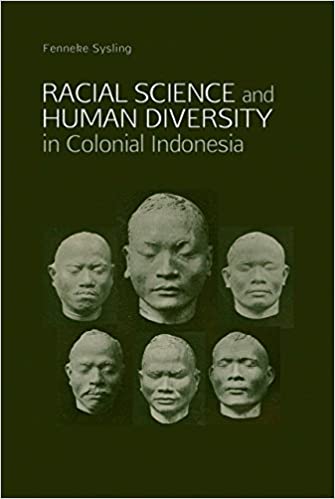
Racial Science And Human Diversity In Colonial Indonesia
Indonesia
Jenis Bahan
Monograf
Judul Alternatif
-
Pengarang
Sysling, Fenneke (Pengarang)
Edisi
Edisi pertama
Pernyataan Seri
-
Penerbitan
Singapore : NUS Press, 2016; © Fenneke Sysling
Bahasa
Inggris
Deskripsi Fisik
viii, 305 halaman : ilustrasi ; 22 cm.
Jenis Isi
teks
Jenis Media
tanpa perantara
Penyimpanan Media
volume
ISBN
9789814722070
ISSN
-
ISMN
-
Bentuk Karya
Tidak ada kode yang sesuai
Target Pembaca
Dewasa
Catatan
Indeks : halaman 297-305|Bibliografi : halaman 254-294
Abstrak
Indonesia is home to diverse peoples who differ from one another in terms of physical appearance as well as social and cultural practices. The way such matters are understood is partly rooted in ideas developed by racial scientists working in the Netherlands Indies beginning in the late nineteenth century, who tried to develop systematic ways to define and identify distinctive races. Their work helped spread the idea that race had a scientific basis in anthropometry and craniology, and was central to people’s identity, but their encounters in the archipelago also challenged their ideas about race. In this new monograph, Fenneke Sysling draws on published works and private papers to describe the way Dutch racial scientists tried to make sense of the human diversity in the Indonesian archipelago. The making of racial knowledge, it contends, cannot be explained solely in terms of internal European intellectual developments. It was ‘on the ground’ that ideas about race were made and unmade with a set of knowledge strategies that did not always combine well. Sysling describes how skulls were assembled through the colonial infrastructure, how measuring sessions were resisted, what role photography and plaster casting played in racial science and shows how these aspects of science in practice were entangled with the Dutch colonial Empire.
| No. Barcode | No. Panggil | Lokasi Perpustakaan | Lokasi Ruangan | Kategori | Akses | Ketersediaan |
|---|---|---|---|---|---|---|
| 00005964803 | R/959.8022 SYS r |
Perpustakaan Jakarta - Cikini Jln. Cikini Raya No. 73, Komplek Taman Ismail marzuki, Jakarta Pusat |
Cikini Referensi Umum - Lantai 4 Anak, Rak Tangga, Lantai 6 | Koleksi Referensi | Baca di tempat | Tersedia |
| No. | Nama File | Nama File Format Flash | Format File | Aksi |
|---|---|---|---|---|
| Tidak ada data. | ||||
| Tag | Ind1 | Ind2 | Isi |
|---|---|---|---|
| 001 | INLIS000000000839938 | ||
| 005 | 20230125013651 | ||
| 007 | ta | ||
| 008 | 230125#########vp#a###e#b######1#|#eng## | ||
| 020 | # | # | $a 9789814722070 |
| 035 | # | # | $a 0010-0123001411 |
| 040 | # | # | $a JKPDJAK$b ind$e rda |
| 041 | 0 | # | $a ing |
| 082 | 1 | 4 | $a 959.8022$2 [23] |
| 084 | # | # | $a R/959.8022 SYS r |
| 100 | 1 | # | $a Sysling, Fenneke$e Pengarang$e Sysling, Fenneke$e Pengarang |
| 245 | 1 | 0 | $a Racial science and human diversity in colonial Indonesia /$c Fenneke Sysling |
| 250 | $a Edisi pertama | ||
| 264 | # | 0 | $a Singapore :$b NUS Press,$c 2016 |
| 264 | # | 4 | $a © Fenneke Sysling |
| 300 | # | # | $a viii, 305 halaman : $b ilustrasi ; $c 22 cm. |
| 336 | # | # | $a teks$2 rdacontent |
| 337 | # | # | $a tanpa perantara$2 rdamedia |
| 338 | # | # | $a volume$2 rdacarrier |
| 500 | # | # | $a Indeks : halaman 297-305 |
| 504 | # | # | $a Bibliografi : halaman 254-294 |
| 520 | 3 | # | $a Indonesia is home to diverse peoples who differ from one another in terms of physical appearance as well as social and cultural practices. The way such matters are understood is partly rooted in ideas developed by racial scientists working in the Netherlands Indies beginning in the late nineteenth century, who tried to develop systematic ways to define and identify distinctive races. Their work helped spread the idea that race had a scientific basis in anthropometry and craniology, and was central to people’s identity, but their encounters in the archipelago also challenged their ideas about race. In this new monograph, Fenneke Sysling draws on published works and private papers to describe the way Dutch racial scientists tried to make sense of the human diversity in the Indonesian archipelago. The making of racial knowledge, it contends, cannot be explained solely in terms of internal European intellectual developments. It was ‘on the ground’ that ideas about race were made and unmade with a set of knowledge strategies that did not always combine well. Sysling describes how skulls were assembled through the colonial infrastructure, how measuring sessions were resisted, what role photography and plaster casting played in racial science and shows how these aspects of science in practice were entangled with the Dutch colonial Empire. |
| 521 | 1 | # | $a Dewasa |
| 650 | # | 4 | $a Arkeologi |
| 650 | # | 4 | $a Penelitian |
| 650 | # | 4 | $a Sejarah |
| 651 | # | 4 | $a Indonesia |
| 850 | # | # | $a JKPDJAK |
| 990 | # | # | $a D002993/23 |